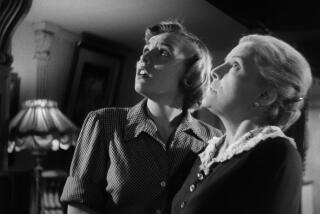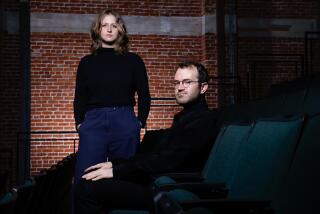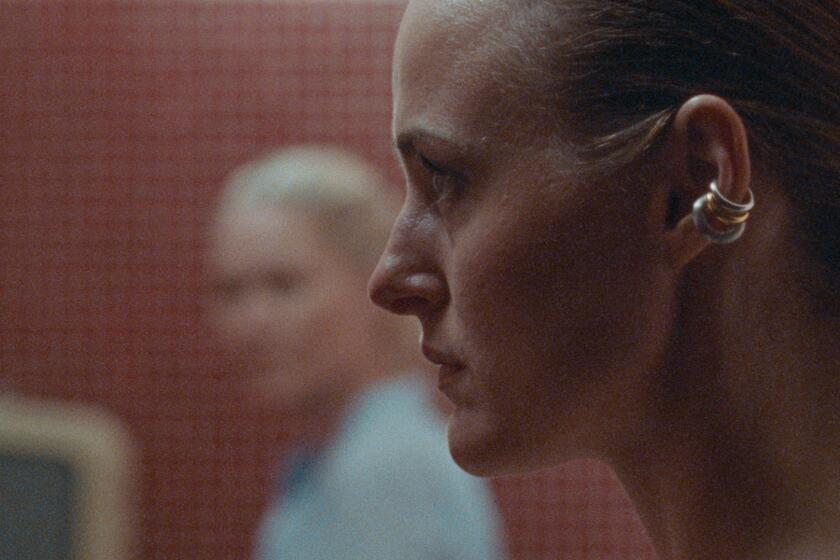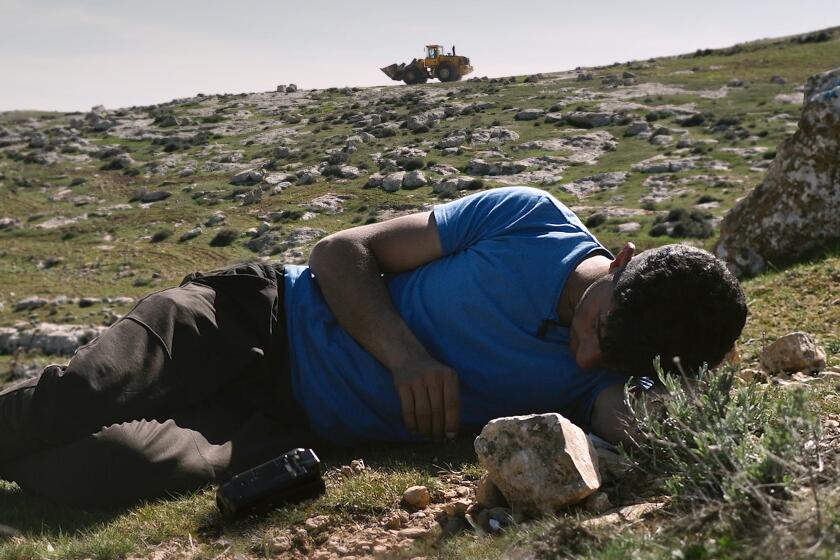Consider the alternatives
- Share via
Let’s say it’s a Tuesday and you’re in the mood to catch a film. Not one of the “Freaky Friday” or “S.W.A.T.” sort, but something unexpected, unusual. A film born and raised outside the studios’ mainstream, the kind that would be lost in a multiplex world. Or perhaps a classic with no big screen afterlife at all. Nowhere else in the world are the options so rich and diverse -- and available -- virtually every day of the week.
For the classics, try an afternoon matinee at the Los Angeles County Museum of Art, where anything from “Superman” with Christopher Reeve to “The Band Wagon,” circa 1953 and starring Fred Astaire and Cyd Charisse, will be screening to an audience populated by screenwriters, retirees, students and even the occasional Miracle Mile suit on a long lunch break.
Then head to the Egyptian Theatre or the New Beverly Cinema in Hollywood, where the choices range from Japanese swordsman films to French gangster pictures. In the same neighborhood, the American Film Institute is usually sponsoring a screening at the ArcLight -- a documentary on an underground band one night, a groundbreaking Russian movie on another.
It is an alternative scene driven by a growing number of distinctive film series shaped by a handful of tastemakers. The curators and programmers at UCLA, the American Cinematheque, the AFI and LACMA are among the more prominent players.
Sweetening the mix are numerous film festivals and the always evocative Last Remaining Seats, an annual series held by the Los Angeles Conservancy in the aging movie palaces of downtown Los Angeles. Then there are those truly on the fringes, the Naz 8 theater in Artesia featuring new films from India and Asia, the occasional screenings at the Forever Hollywood cemetery and the Pacific Northridge, a shabby discount theater that is one of the few remaining tenants in a lonely strip mall and often the very last place in the area to catch a mainstream film released months ago.
So whether you consider yourself a casual movie fan or a certified cineaste, in this town it’s possible to construct an alternative film festival of your very own.
American Cinematheque
It may be hard to imagine people feverishly lining up around the block to see a movie such as “Dr. No,” the 1962 film that launched James Bond as a film franchise. Between home video and cable, “Dr. No” is certainly not out of circulation. But long lines happen all the time at the Egyptian, the restored movie palace about to celebrate its 80th birthday.
The theater has memories as well as movies -- the electric buzz that took the room when beloved actor Farley Granger (best know for his role in Alfred Hitchcock’s 1951 film “Strangers on a Train”) once appeared, or Shirley Jones introducing a screening of “Oklahoma!” and remembering the film’s original premiere at the Egyptian.
The American Cinematheque at the Egyptian has in many ways made its mark on the local scene by featuring obscure genre films, as it did in its recent Festival of Fantasy, Horror and Science Fiction. But Dennis Bartok, a programmer at the American Cinematheque, chuckles at the notion that the theater caters to the “film geek” crowd, saying, “I’ve been called a film geek, but I didn’t realize we were known for geek cinema.”
Bartok, 38, has been with the Cinematheque since 1992. He and the team of other programmers working at the Cinematheque fill its schedule with new American independent films, foreign films new and old, and classic Hollywood films. They also work hard to bring in directors, producers, writers or actors affiliated with a film for introductions and post-screening Q & As.
In a twist that speaks to the dedication of the Cinematheque’s audience, Bartok says that after scheduling the new film “Love Object” for the horror series, he realized that Robert Parigi, the writer and director of the film, was a familiar face from other screenings.
Though he expresses some concern over DVD and home video eating away at the audience for revival screenings, Bartok is not entirely worried.
“It’s great to watch ‘Lawrence of Arabia’ on a beautifully restored DVD with lots of extras,” he says, “but you’re never going to get the same experience as seeing a beautiful 70-millimeter print of that film projected on a big screen. It’s just not the same experience at all. It’s a little like comparing a live concert experience to listening to a CD. They are both great experiences, but they are very different ones.”
There is an upside to the DVD explosion -- an increased cooperation from major studios looking for ways to promote their releases. A recent event, for example, featured the cast and crew of “The Right Stuff.”
“The different studios have been a great asset for obtaining new prints or getting guests to come down to the theater,” says Bartok. “It goes a long way toward promoting film culture and the love of film.”
UCLA
Last spring, the opening night of UCLA’s “Heroic Grace: The Chinese Martial Arts Film,” a series that reclaimed and restored a sense of dignity and artistry to the much-mocked style, had the excitement and expectation of a rock concert. Dignitaries and film directors mingled with hard-core action fans before the screening of the 1977 Hong Kong picture “Executioners From Shaolin.” By evening’s end, after countless kicks, punches and gouges, no one seemed disappointed.
The programming at UCLA has the advantage of drawing from the extensive Film and Television Archive, an enormous media collection second in size only to the Library of Congress’.
“The archive works largely to preserve classic Hollywood cinema,” says Andrea Alsberg, co-head of programming at the archive, “and we like to showcase that work, obviously. The time and care the folks down at the vault, as we call it, take to restore a film is amazing. The archive is also starting to work on preserving independent films, experimental films, documentaries, all of which are deteriorating as well.”
But films from the archive are just a portion of what UCLA screens, having been a leader in showing films from around the world. The campus’ James Bridges Theater was one of the first venues in the United States to showcase the works of many now-established international directors, such as Pedro Almodovar. Its recent survey of Chinese martial arts films was a smash here in Los Angeles and has continued to draw crowds as it has toured the country.
Alsberg, 43, has been with the archive for 12 years, while her fellow co-head of public programming, Cheng-Sim Lim, 41, has been with the archive for eight years.
Though set on the UCLA campus, students make up only a small portion of the audience for the screenings, Lim says -- putting it at around 8% to 10%.
“Sometimes people don’t realize we’re a public venue, they think we’re just for students, which is not the case,” says Lim. “And when many people think of UCLA, they think of parking as a real hassle. Hopefully, if someone comes down just once they will realize that we’re more accessible than they might think.”
Some of those problems will be eliminated when the screenings move off campus to the new Billy Wilder Theater in the Hammer Museum around 2005. Spurred on by a $5-million donation by the late director’s wife, Audrey, the move will put the archive’s screenings right at the bustling corner of Wilshire and Westwood boulevards.
In the meantime, renovations are being completed to the on-campus theater to update the sound system, which Lim says will make it the only screening facility in L.A. besides the Academy of Motion Picture Arts and Sciences screening room capable of showing everything from outdated nitrate prints and variable-speed films to the latest in digital technology.
LACMA
Though part of the cluster of modernist buildings that make up the LACMA compound, the museum’s Leo S. Bing Theater has all the architectural appeal of a suburban high school auditorium. Once the lights go down, though, one can be transported anywhere, from the intellectually rigorous inquiry into late-’60s life in Jean-Luc Godard’s rarely seen “Letter to Jane” to the freewheeling fun of Howard Hawks’ “His Girl Friday.”
LACMA’s Tuesday matinee series is a film junkie’s delight -- it’s cheap (only $2, $1 for seniors), the prints are generally good and you know full well there is something more productive you should be doing instead. Plus, LACMA is the one venue in town whose audience nearly matches the notoriously cantankerous crowd of New York’s Museum of Modern Art screenings. Nowhere else in L.A. does shushing often seem an invitation to brawling.
The main programs at LACMA often relate to other exhibitions in the museum, such as the recent series of classic Japanese films chosen by writer Susan Sontag. Also in line with its museum affiliation, programmer Ian Birnie tries to give special attention to the visual craft of filmmaking, with series focusing on costume design, art direction or cinematography.
A veteran programmer, Birnie came to the museum in 1996 from distributor Janus Films, one of the leading sources for classic film prints, and had previously been involved in special series at film festivals in Cannes, Toronto and Berlin.
One change Birnie has noticed involves the availability of the actual film prints shown at the museum. “The situation has reversed from 15 or 20 years ago, when classic American films were hard to see,” Birnie said via e-mail. “Now, classic European films have all but disappeared from distribution, most of those prints come from archives or Europe. I am presenting a Jean Cocteau retrospective in September and over half the prints are being flown in from France.”
American Film Institute
The venerable American Film Institute, programmed by Christian Gaines, director of festivals, is in a way a newcomer on the scene.
Though the AFI has long organized its AFI Fest, one of the biggest and most high-profile film festivals in the area, it has only been in the last year or so that the institute has put on regular, year-round programming.
Gaines, 38, has been with the AFI for three years, having previously served as director of the Hawaii International Film Festival and as a programmer at the Sundance Film Festival.
The impetus for the new programming, says Gaines, is the “growth in the alternative exhibition audience, and a real increase in the willingness of people to try out something new.”
The dynamics of a diverse city also have helped the AFI establish a unique programming identity within the alternative world.
“It’s a big town, with a lot of different people with a lot of different interests,” Gaines says. “Everyone looks at everyone else’s programming to make sure you’re not replicating something. I really don’t see any overlap.... The American Cinematheque, UCLA and other venues around town are doing great stuff, and hopefully there’s room for us too.”
Rather than holding screenings at the AFI’s headquarters near Griffith Park, the institute has opted instead to partner with the ArcLight in Hollywood and the Skirball Cultural Center near Westwood. Though it might seem a disadvantage not having a permanent, dedicated screening venue, AFI programming associate Erin Anderson, 29, says the setup has its advantages.
“I quite like having multiple venues. It keeps the audience changing, and allows us to show films to a wider range of people,” says Anderson, who came to the AFI in April of last year. “The Skirball brings in people from the Westside and the ArcLight attracts a more Eastside crowd.”
The Cinema’s Legacy series at Skirball Center is one of AFI’s centerpiece programs. It features filmmakers screening and discussing their favorite films. (UCLA also has a similar series, its long-running the Movie That Inspired Me program.)
Filmmakers at the Skirball have included Wim Wenders showing “Rules of the Game,” Stephen Frears showing “The Third Man” and William Friedkin showing “Paths of Glory.” Featured filmmakers for the upcoming season include Spike Lee, Kathy Bates, Lawrence Kasdan and Alejandro Gonzalez Inarritu.
“We’ve only been programming for a year, but I for one feel people are responding in an encouraging way,” Anderson says. “It’s largely a matter of getting our programming into the local film dialogue: ‘Hey, what are you going to see?’ Where the Cinematheque or the Sunset 5 already has its name, we’re building ours.”
Anderson’s remark points out an interesting intersection -- within the landscape of alternative venues in Los Angeles are two locally based exhibitors specializing in art house and foreign films: Landmark Theatres and Laemmle Theaters. As Bob Laemmle, president of Laemmle Theaters points out, though his theaters may be more closely aligned with such institutions as LACMA or UCLA in spirit, there are some crucial differences.
“They are nonprofit institutions, where we are in trenches,” says Laemmle. “So from that standpoint, I have more of an affinity with the struggles of the commercial multiplex to exist economically, but I do probably identify more with the programming concepts of these other institutions.”
These sentiments are echoed by Burt Manzari, executive vice president of the Landmark chain. Talking about the “handmade booking” policies of such Landmark venues as the Nuart or the Westside Pavilion, he says, “We talk all the time about things we’d like to do, but we can’t because we just don’t think they are economically viable.”
In areas such as Pasadena, where Laemmle has gone from one screen to seven, the growth in attendance points to a growing, or at the very least underserved, audience for specialized films. Manzari has found that if you build it, they will come.
“I’m perpetually amazed at how well educated people are about the films currently on the circuit,” he says. “Those that are immersed in this world of non-studio film are just voracious in their appetite for it.”
Battling traffic, buying tickets and finding seats rarely seems like such a bother once the lights go down. From local art house chains to institutional venues to “micro-cinemas” such as the Echo Park Film Center or Cinespace, there is always something new, something different, something unseen, waiting to be discovered in the dark.
Searching for a reason for what draws people to the growing number of alternative exhibition venues in Los Angeles, the AFI’s Gaines is reluctant to point a finger at dissatisfaction with more mainstream Hollywood product.
“I flinch a little bit at the refugee notion,” he says. Then he adds: “I would love to think that somehow people who come to our programs are refugees from big-budget movies, but I really don’t think that’s true. I do think the moviegoer has become more sophisticated because of the increased resources available to them and the increased options of what to see.”
As UCLA’s Lim puts it: “In L.A., film culture has really improved, simply because there’s more going on. We’re lifting the boat together.”
*
Get with the program
American Cinematheque
Lloyd E. Rigler Theatre at the Egyptian,
6712 Hollywood Blvd., Hollywood.
(323) 461-2020
Upcoming programs include a tribute to French filmmaker Chris Marker (Sept. 5-7), a series of new films from Mexico (Oct. 2-4) and a tribute to director David Lean (Oct. 10-Nov. 2).
Info: www.americancinematheque.com
American Film Institute
2021 N. Western Ave., Los Angeles
(323) 856-7600
Ongoing programs include AFI at ArcLight, Cinema’s Legacy at the Skirball Center and the AFI Fest, which runs Nov. 6-16.
Info: www.afi.com/exhibition
Los Angeles County Museum of Art
Leo S. Bing Theater, 5905 Wilshire Blvd., Los Angeles. (213) 763-3466
Upcoming programs include a 15th-anniversary screening of Wim Wenders’ “Wings of Desire” with a new 35-millimeter print with newly translated subtitles (Aug. 29-30).
Info: www.lacma.org
UCLA Film and Television Archive
James Bridges Theater, 1409 Melnitz Hall, UCLA campus, Westwood
(310) 206-8013
Upcoming programs include a series featuring pioneering Mexican filmmaker Fernando de Fuentes (Sept. 29-Oct. 5), a retrospective of Italian filmmakers Paolo and Vittorio Taviani (Oct. 3-27) and a preview of the latest work by Chinese director Cui Zien (Oct. 15).
Info: www.cinema.ucla.edu
Notable micro cinemas
Cinespace
6356 Hollywood Blvd., Los Angeles
(323) 817-3456
Info: www.cine-space.com
Echo Park Film Center
1200 N. Alvarado St., Los Angeles
(213) 484-8846
Info: www.echoparkfilmcenter.org
On the Web
For a listing of alternative screenings in Los Angeles, try www.filmradar.com.
Mark Olsen can be contacted at [email protected].
More to Read
Only good movies
Get the Indie Focus newsletter, Mark Olsen's weekly guide to the world of cinema.
You may occasionally receive promotional content from the Los Angeles Times.











